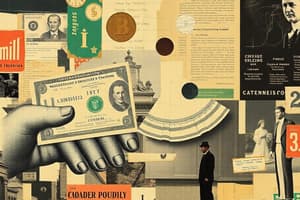Podcast
Questions and Answers
What characterizes informal sources of credit compared to formal sources?
What characterizes informal sources of credit compared to formal sources?
- They are often unregulated and can charge higher interest rates. (correct)
- They require proper documentation.
- They are regulated for interest rates.
- They offer more transparent loan terms.
What is a primary challenge faced by individuals seeking formal credit?
What is a primary challenge faced by individuals seeking formal credit?
- Formal credit often offers lower interest rates than informal sources.
- Documentation and collateral requirements may be inaccessible. (correct)
- Less privileged groups prefer informal sources for their benefits.
- Formal credit sources are equally available to marginalized communities.
How do self-help groups (SHGs) empower their members?
How do self-help groups (SHGs) empower their members?
- By reducing the interest rates charged by informal lenders.
- By allowing members to access loans without any requirements.
- By providing loans that only focus on personal consumption.
- By pooling savings to create funds and offering loans to members. (correct)
Which of the following describes a benefit of being part of a self-help group (SHG)?
Which of the following describes a benefit of being part of a self-help group (SHG)?
What role do self-help groups play in accessing larger loans?
What role do self-help groups play in accessing larger loans?
What is a primary reason money was invented as a medium of exchange?
What is a primary reason money was invented as a medium of exchange?
Which institution is solely responsible for issuing currency notes in India?
Which institution is solely responsible for issuing currency notes in India?
What do banks do with a portion of the deposits they accept?
What do banks do with a portion of the deposits they accept?
Which of the following best describes credit?
Which of the following best describes credit?
What is one of the key components of the terms of credit?
What is one of the key components of the terms of credit?
How do formal sources of credit differ from informal sources?
How do formal sources of credit differ from informal sources?
Why do banks pay lower interest on deposits than they charge on loans?
Why do banks pay lower interest on deposits than they charge on loans?
What can be a potential negative effect of using credit?
What can be a potential negative effect of using credit?
Flashcards
Formal Sources of Credit
Formal Sources of Credit
Sources of credit that are regulated by government bodies, ensuring fairness and accountability in interest rates and lending practices. Examples include banks, credit unions, and government-backed loan programs.
Informal Sources of Credit
Informal Sources of Credit
Sources of credit that operate outside of formal regulations, often charging high interest rates with less transparency. Examples include money lenders, friends, and family.
Debt Trap
Debt Trap
The situation where high interest rates on loans make repayment difficult, leading to a cycle of borrowing and debt.
Self-Help Groups (SHGs)
Self-Help Groups (SHGs)
Signup and view all the flashcards
Financial Inclusion
Financial Inclusion
Signup and view all the flashcards
Barter System
Barter System
Signup and view all the flashcards
Money
Money
Signup and view all the flashcards
Currency
Currency
Signup and view all the flashcards
Demand Deposits
Demand Deposits
Signup and view all the flashcards
Credit
Credit
Signup and view all the flashcards
Interest Rate
Interest Rate
Signup and view all the flashcards
Formal Credit
Formal Credit
Signup and view all the flashcards
Informal Credit
Informal Credit
Signup and view all the flashcards
Study Notes
Money as Medium of Exchange
- Before money, goods were exchanged using the barter system, requiring a direct exchange of goods or services where both individuals had mutual needs.
- Money was invented to facilitate transactions regardless of the needs of the other party involved.
- Money acts as a medium of exchange.
- Precious metals and cattle were used as early forms of money.
Modern Forms of Money
- Currency notes, authorized by the government, are a common form of modern money used for transactions.
- The Reserve Bank of India (RBI) is the sole entity authorized to issue currency in India.
- Deposit accounts in banks are another form of modern money.
- Banks operate on a demand deposit system, allowing depositors to withdraw funds whenever needed.
- Demand deposits enable transactions through checks, eliminating the need for physical cash in many cases.
Functions of Banks
- Banks accept deposits from individuals and lend money to those who need it.
- Banks charge interest on loans they provide.
- Banks pay interest on customer deposits, however, the interest offered to depositors is usually lower than the interest charged on loans.
- This difference in interest rates is the primary source of income for banks.
- Banks maintain reserves to ensure adequate funds for daily operations and customer withdrawals.
Credit
- Credit is a temporary loan of money.
- Individuals can access credit from banks or other sources like individuals.
- Credit is used for purchasing goods, services, or investment purposes.
- Credit use can be beneficial or detrimental depending on how it is used and an individual's ability to repay.
Terms of Credit
- Understanding and agreeing upon credit terms is crucial before taking out a loan.
- Credit terms include documentation (necessary paperwork), collateral (asset for security against defaults), mode of repayment (schedule), and the interest rate (percentage charged for borrowing).
- Credit terms vary depending on lenders (e.g., banks, moneylenders).
Formal and Informal Sources of Credit
- Formal credit sources, like banks and cooperatives, have transparent terms regulated by the Reserve Bank of India (RBI).
- Formal sources are monitored for fair interest rates and loan allocation, ensuring transparency and accountability.
- Informal credit sources, including moneylenders, friends, or relatives, operate without regulation.
- Informal sources can have less transparent lending practices and potentially higher interest rates.
Challenges with Credit
- High interest rates from informal credit sources can easily create debt traps.
- Formal credit sources sometimes require documentation and collateral that might be inaccessible to some individuals, pushing them to informal lenders.
Self-Help Groups (SHGs)
- Self-help groups (SHGs) provide financial inclusion and access to credit for marginalized communities.
- Typically composed of 15-20 members in a local area, saving and lending to each other.
- SHG members enjoy lower interest rates and flexible repayment schedules, lowering the risk of debt traps.
- SHGs promote financial discipline and community support.
- Building evidence of financial responsibility allows SHGs to gain trust from banks to secure larger loans for their members.
- SHGs empower individuals by providing financial independence and community involvement.
- Grameen Bank of Bangladesh, founded by Muhammad Yunus, is a notable SHG example that promotes responsible financial practices, focusing on empowering the underprivileged.
Studying That Suits You
Use AI to generate personalized quizzes and flashcards to suit your learning preferences.




